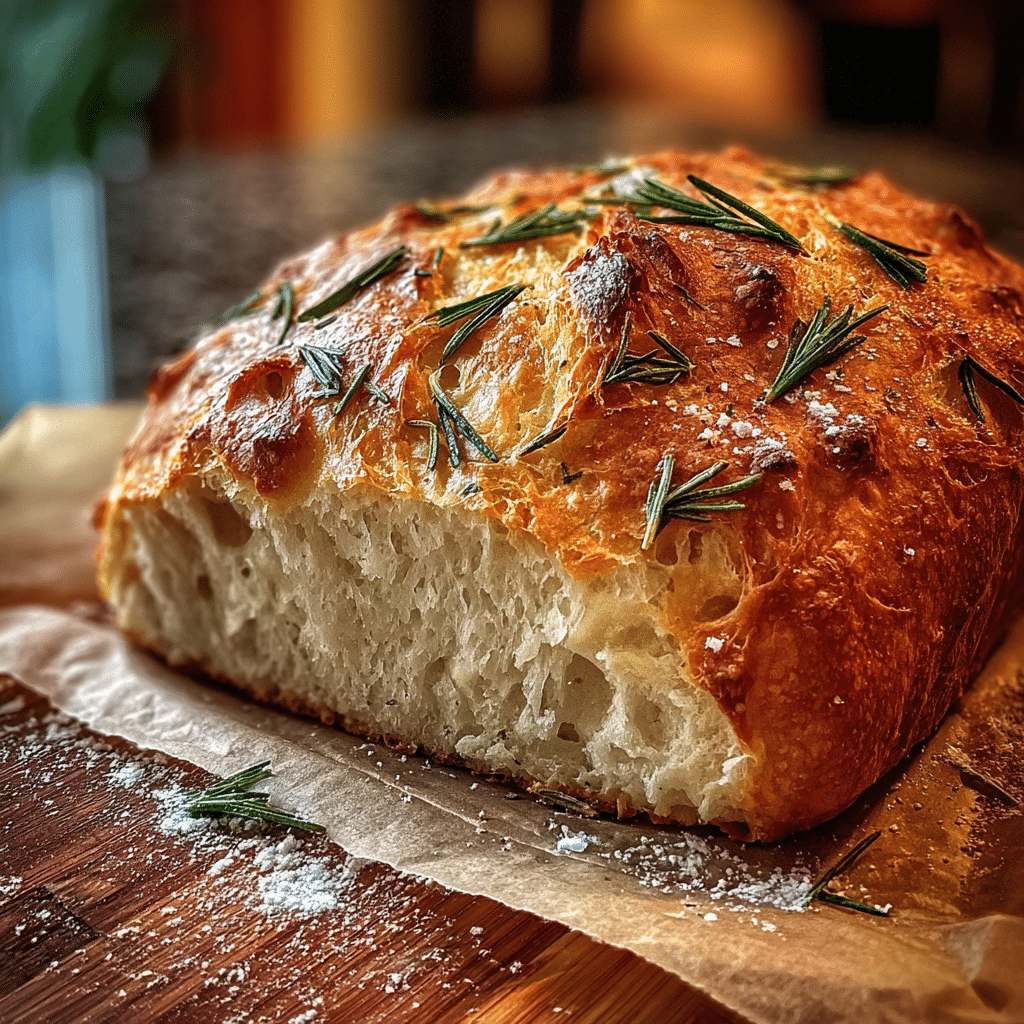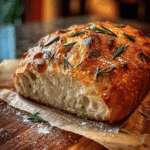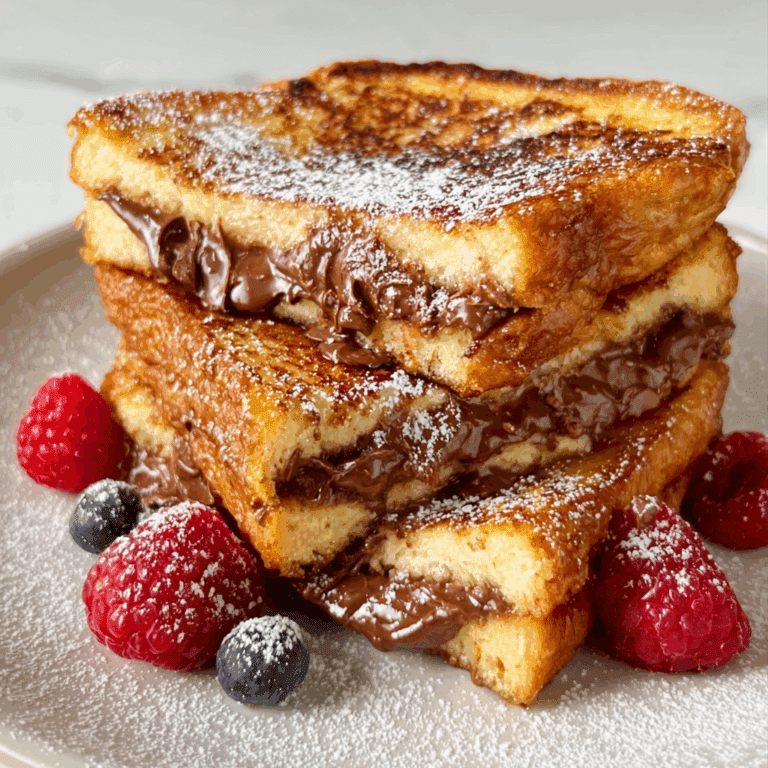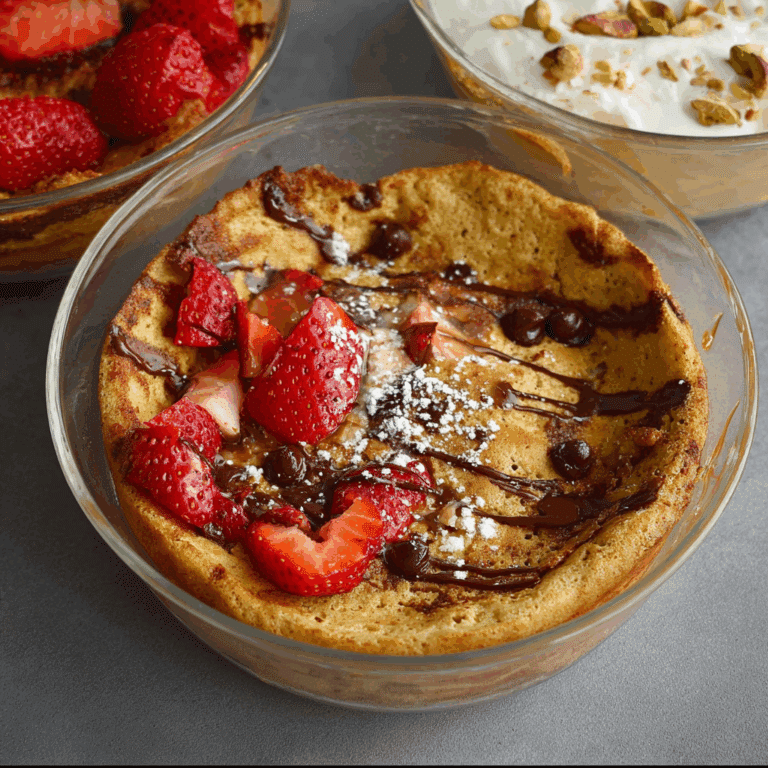Why No Knead Rosemary Bread Is Perfect for Beginners

If you’ve ever dreamed of baking bread at home without the fuss of traditional kneading, then No Knead Rosemary Bread is your new best friend in the kitchen. This delightful loaf combines fluffy texture and aromatic rosemary flavors with the ease perfect for beginners craving homemade goodness. With simple ingredients and a relaxed process, it’s a recipe that welcomes everyone to the world of bread baking.
Why You’ll Love This Recipe
- Effortless preparation: Requires minimal active time, no kneading needed, making it perfect for beginners.
- Rustic flavor: The fresh rosemary infuses the bread with a fragrant, savory aroma that elevates every bite.
- Perfect texture: Develops a crispy crust and soft, airy interior without complicated techniques.
- Versatile use: Great for sandwiches, dipping, or enjoying plain with butter.
- Minimal ingredients: Uses pantry staples, making it accessible and budget-friendly for everyone.
Ingredients You’ll Need
The beauty of the No Knead Rosemary Bread recipe lies in its simple, essential ingredients. Each one plays a crucial role, whether it’s the flour providing structure, the yeast activating natural rise, or the rosemary adding fresh herbal notes.
- All-purpose flour: The base of the bread, giving it the right gluten for texture and rise.
- Instant yeast: Helps the dough rise gently without needing active kneading or proofing.
- Warm water: Activates the yeast and hydrates the flour for dough formation.
- Salt: Enhances flavor and strengthens the dough’s gluten network.
- Fresh rosemary: Adds a fragrant, earthy aroma and taste that makes this bread special.
- Olive oil (optional): For brushing the crust and adding a subtle richness.
Variations for No Knead Rosemary Bread
This recipe is incredibly adaptable, inviting you to personalize your loaf based on your pantry, dietary preferences, or craving for different flavors. Feel free to get creative with these easy variations.
- Herbs mix: Swap rosemary for thyme, oregano, or basil for a different herbal twist.
- Garlic infusion: Add minced garlic or garlic powder for a savory kick.
- Whole wheat blend: Replace part of the all-purpose flour with whole wheat for extra fiber and nuttiness.
- Cheese addition: Fold in shredded Parmesan or cheddar for a cheesy crumb.
- Seed toppings: Sprinkle sesame, poppy, or sunflower seeds on top before baking for crunch and visual appeal.

How to Make No Knead Rosemary Bread
Step 1: Mix the Dough
Combine flour, instant yeast, salt, and fresh rosemary in a large bowl. Stir in warm water until a shaggy, sticky dough forms. No need for kneading—just mix until everything is combined.
Step 2: Let the Dough Rise
Cover the bowl with plastic wrap or a clean towel and let the dough rise at room temperature for 12 to 18 hours. During this time, the dough will develop bubbles and expand, becoming airy and fluffy.
Step 3: Shape the Loaf
Lightly flour a work surface. Turn the dough out and fold it over on itself a few times to form a rough ball. Let it rest for 15 minutes to relax the gluten.
Step 4: Second Proof
Place the shaped dough on a parchment-lined baking sheet or a proofing basket. Cover and let it rise for another 1 to 2 hours until it puffs up again.
Step 5: Bake to Perfection
Preheat your oven and a heavy Dutch oven or cast iron pot to 450°F (232°C). Transfer the dough into the hot pot, cover with the lid, and bake for 30 minutes. Remove the lid and bake for an additional 10-15 minutes to achieve a golden, crisp crust.
Pro Tips for Making No Knead Rosemary Bread
- Use room temperature water: Ensures the yeast activates without being killed by heat.
- Don’t skip the long rise: The extended fermentation develops flavor and a wonderful texture.
- Handle dough gently: Avoid rough kneading to keep the air bubbles intact.
- Preheat your baking vessel: A hot Dutch oven mimics a steam oven, crucial for crustiness.
- Add rosemary at the right time: Stir it into the dry ingredients so the aroma infuses evenly.
How to Serve No Knead Rosemary Bread
Garnishes
A light brushing of olive oil and a sprinkle of flaky sea salt right after baking boosts the bread’s fragrance and adds a glossy sheen that’s irresistible.
Side Dishes
This bread pairs beautifully with soups like tomato basil or creamy mushroom, alongside olive oil and balsamic vinegar for dipping, or simply with soft butter melting into its warm crumb.
Creative Ways to Present
Slice the bread thick for a rustic sandwich, chop into cubes for croutons, or toast slices and top with fresh tomatoes and mozzarella for an instant appetizer everyone will love.
Make Ahead and Storage
Storing Leftovers
Keep your leftover No Knead Rosemary Bread wrapped tightly in a clean kitchen towel or paper bag at room temperature for up to three days to maintain its crust and interior softness.
Freezing
This bread freezes well when sliced; wrap slices in plastic wrap and place them in a freezer bag. They can be stored for up to three months without losing flavor or texture.
Reheating
For best results, reheat frozen or day-old bread in a 350°F (175°C) oven for 10 minutes to refresh the crust and warm the soft inside—just like it was freshly baked.
FAQs
Is No Knead Rosemary Bread difficult for beginners?
Not at all! It’s one of the simplest bread recipes, requiring no kneading and only a few basic steps that anyone can follow.
Can I use dried rosemary instead of fresh?
Yes, dried rosemary can be used, but fresh rosemary offers a stronger, more vibrant flavor that really makes the bread special.
Do I need a Dutch oven for baking?
While a Dutch oven helps create a perfect crust by trapping steam, you can bake the bread on a baking sheet covered with an oven-safe bowl if needed.
How long does the dough need to rise?
The initial rise should be 12 to 18 hours at room temperature to develop flavor and texture, followed by a shorter second rise of 1 to 2 hours after shaping.
Can I add other herbs or flavorings?
Absolutely! Rosemary is the classic choice, but you can experiment with herbs like thyme, oregano, or add ingredients like olives or cheese for variations.
Final Thoughts
Baking No Knead Rosemary Bread is a joyous adventure that welcomes even the most novice bakers to experience homemade bread’s magic. Its simplicity, combined with the aromatic charm of rosemary, makes it a recipe worth sharing and savoring time and time again. Grab your ingredients, follow these friendly steps, and treat yourself to the delightful reward of fresh, homemade bread!
Related Posts
- Why Baked Protein Pancake Bowl Is a Must-Try
- Why Try This Veggie-Packed Cottage Cheese Egg Bake?
- Irresistible Bay Lobster Eggs Benedict with Cajun Hollandaise
No Knead Rosemary Bread
No Knead Rosemary Bread is a simple, beginner-friendly bread recipe that requires no kneading and minimal active time. Infused with fresh rosemary, it delivers a rustic, aromatic flavor, a crispy crust, and a soft, airy interior. Perfect for sandwiches, dipping, or enjoying plain with butter, this loaf uses pantry staples and offers versatile variations to suit all tastes.
- Prep Time: 15 minutes
- Cook Time: 40-45 minutes
- Total Time: 13 to 19 hours
- Yield: 1 loaf 1x
- Category: Breads
- Method: Baking
- Cuisine: American
- Diet: Vegetarian
Ingredients
Main Ingredients
- 3 cups all-purpose flour
- 1/4 teaspoon instant yeast
- 1 1/4 teaspoons salt
- 1 tablespoon fresh rosemary, finely chopped
- 1 1/2 cups warm water (around room temperature)
Optional Ingredients
- Olive oil for brushing the crust
Instructions
- Mix the Dough: Combine the all-purpose flour, instant yeast, salt, and fresh rosemary in a large bowl. Stir in the warm water until a shaggy, sticky dough forms. There is no kneading—just mix until everything is combined.
- Let the Dough Rise: Cover the bowl with plastic wrap or a clean towel, and let the dough rise at room temperature for 12 to 18 hours. During this time, the dough will bubble and expand, becoming airy and fluffy.
- Shape the Loaf: Lightly flour a work surface and turn the dough out. Fold it over on itself a few times to form a rough ball. Let it rest for 15 minutes to relax the gluten.
- Second Proof: Place the shaped dough on a parchment-lined baking sheet or in a proofing basket. Cover and let it rise for another 1 to 2 hours until it puffs up again.
- Bake to Perfection: Preheat your oven and a heavy Dutch oven or cast iron pot to 450°F (232°C). Transfer the dough into the hot pot, cover with the lid, and bake for 30 minutes. Remove the lid and bake for an additional 10 to 15 minutes until the crust is golden and crisp.
Notes
- Use room temperature water to ensure yeast activation without killing it.
- Don’t skip the long rise; extended fermentation develops flavor and texture.
- Handle the dough gently to preserve air bubbles.
- Preheat your baking vessel; a hot Dutch oven mimics a steam oven for crustiness.
- Stir rosemary into dry ingredients for even aroma infusion.
- Brush freshly baked bread with olive oil and sprinkle flaky sea salt for enhanced fragrance and gloss.
Nutrition
- Serving Size: 1 slice (approx. 60g)
- Calories: 150
- Sugar: 0g
- Sodium: 220mg
- Fat: 1.5g
- Saturated Fat: 0.2g
- Unsaturated Fat: 1.3g
- Trans Fat: 0g
- Carbohydrates: 30g
- Fiber: 1g
- Protein: 5g
- Cholesterol: 0mg
Keywords: no knead bread, rosemary bread, easy bread recipe, homemade bread, beginner bread baking, rustic bread







